Case Study | The control of the glycemic level, blood glucose levels, or after meals.
VerifiedAdded on 2022/10/01
|8
|1989
|43
AI Summary
Contribute Materials
Your contribution can guide someone’s learning journey. Share your
documents today.
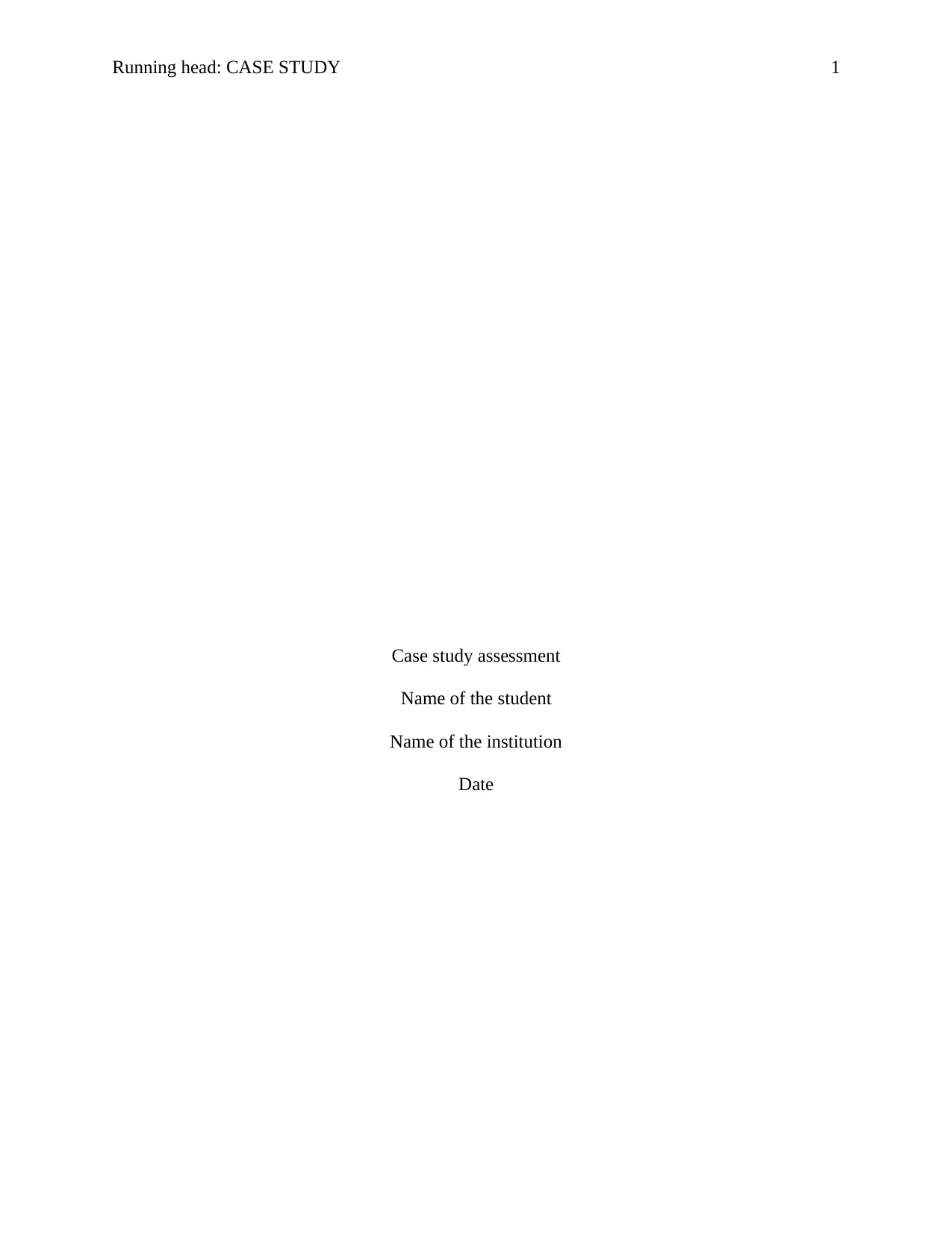
Running head: CASE STUDY 1
Case study assessment
Name of the student
Name of the institution
Date
Case study assessment
Name of the student
Name of the institution
Date
Secure Best Marks with AI Grader
Need help grading? Try our AI Grader for instant feedback on your assignments.
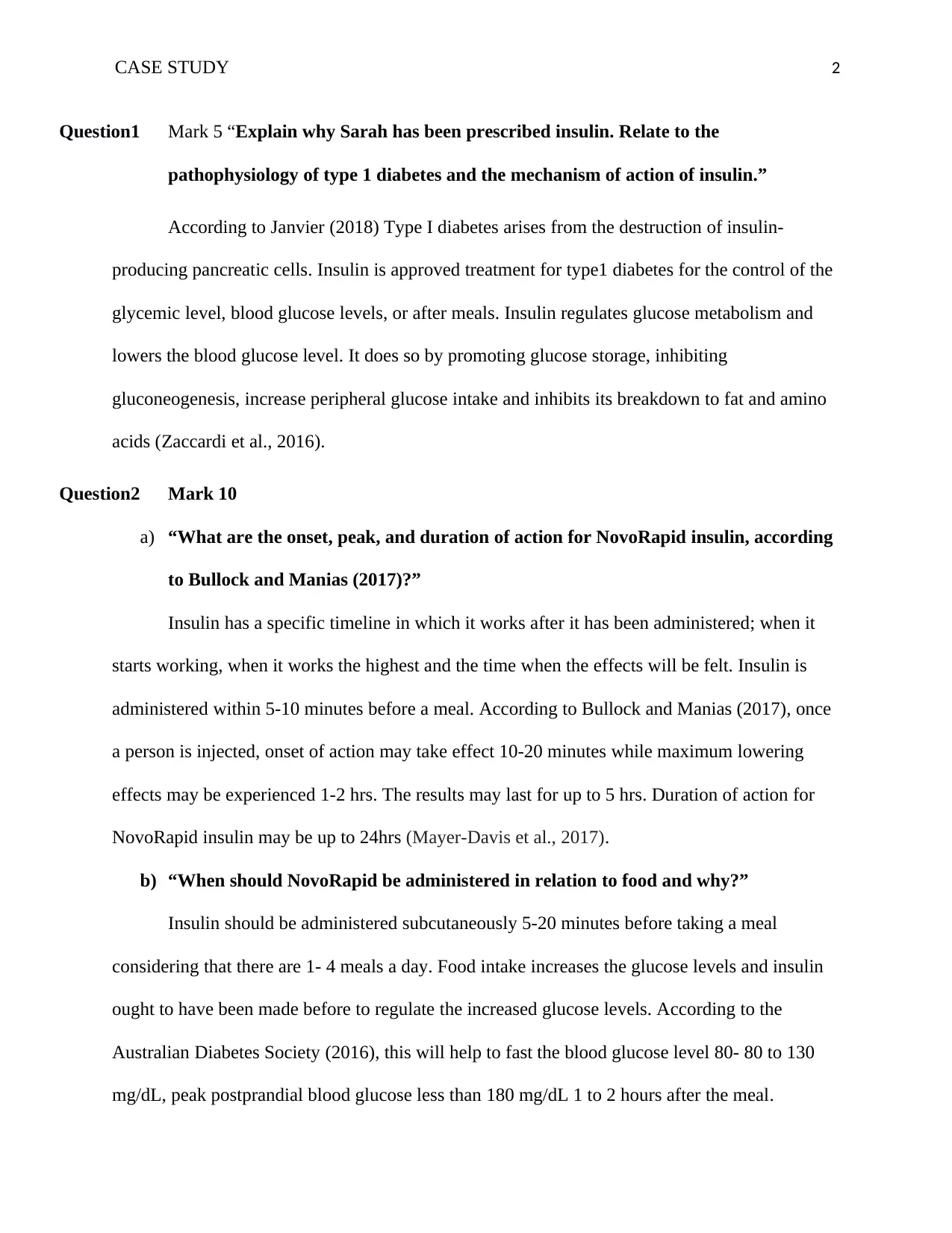
CASE STUDY 2
Question1 Mark 5 “Explain why Sarah has been prescribed insulin. Relate to the
pathophysiology of type 1 diabetes and the mechanism of action of insulin.”
According to Janvier (2018) Type I diabetes arises from the destruction of insulin-
producing pancreatic cells. Insulin is approved treatment for type1 diabetes for the control of the
glycemic level, blood glucose levels, or after meals. Insulin regulates glucose metabolism and
lowers the blood glucose level. It does so by promoting glucose storage, inhibiting
gluconeogenesis, increase peripheral glucose intake and inhibits its breakdown to fat and amino
acids (Zaccardi et al., 2016).
Question2 Mark 10
a) “What are the onset, peak, and duration of action for NovoRapid insulin, according
to Bullock and Manias (2017)?”
Insulin has a specific timeline in which it works after it has been administered; when it
starts working, when it works the highest and the time when the effects will be felt. Insulin is
administered within 5-10 minutes before a meal. According to Bullock and Manias (2017), once
a person is injected, onset of action may take effect 10-20 minutes while maximum lowering
effects may be experienced 1-2 hrs. The results may last for up to 5 hrs. Duration of action for
NovoRapid insulin may be up to 24hrs (Mayer-Davis et al., 2017).
b) “When should NovoRapid be administered in relation to food and why?”
Insulin should be administered subcutaneously 5-20 minutes before taking a meal
considering that there are 1- 4 meals a day. Food intake increases the glucose levels and insulin
ought to have been made before to regulate the increased glucose levels. According to the
Australian Diabetes Society (2016), this will help to fast the blood glucose level 80- 80 to 130
mg/dL, peak postprandial blood glucose less than 180 mg/dL 1 to 2 hours after the meal.
Question1 Mark 5 “Explain why Sarah has been prescribed insulin. Relate to the
pathophysiology of type 1 diabetes and the mechanism of action of insulin.”
According to Janvier (2018) Type I diabetes arises from the destruction of insulin-
producing pancreatic cells. Insulin is approved treatment for type1 diabetes for the control of the
glycemic level, blood glucose levels, or after meals. Insulin regulates glucose metabolism and
lowers the blood glucose level. It does so by promoting glucose storage, inhibiting
gluconeogenesis, increase peripheral glucose intake and inhibits its breakdown to fat and amino
acids (Zaccardi et al., 2016).
Question2 Mark 10
a) “What are the onset, peak, and duration of action for NovoRapid insulin, according
to Bullock and Manias (2017)?”
Insulin has a specific timeline in which it works after it has been administered; when it
starts working, when it works the highest and the time when the effects will be felt. Insulin is
administered within 5-10 minutes before a meal. According to Bullock and Manias (2017), once
a person is injected, onset of action may take effect 10-20 minutes while maximum lowering
effects may be experienced 1-2 hrs. The results may last for up to 5 hrs. Duration of action for
NovoRapid insulin may be up to 24hrs (Mayer-Davis et al., 2017).
b) “When should NovoRapid be administered in relation to food and why?”
Insulin should be administered subcutaneously 5-20 minutes before taking a meal
considering that there are 1- 4 meals a day. Food intake increases the glucose levels and insulin
ought to have been made before to regulate the increased glucose levels. According to the
Australian Diabetes Society (2016), this will help to fast the blood glucose level 80- 80 to 130
mg/dL, peak postprandial blood glucose less than 180 mg/dL 1 to 2 hours after the meal.
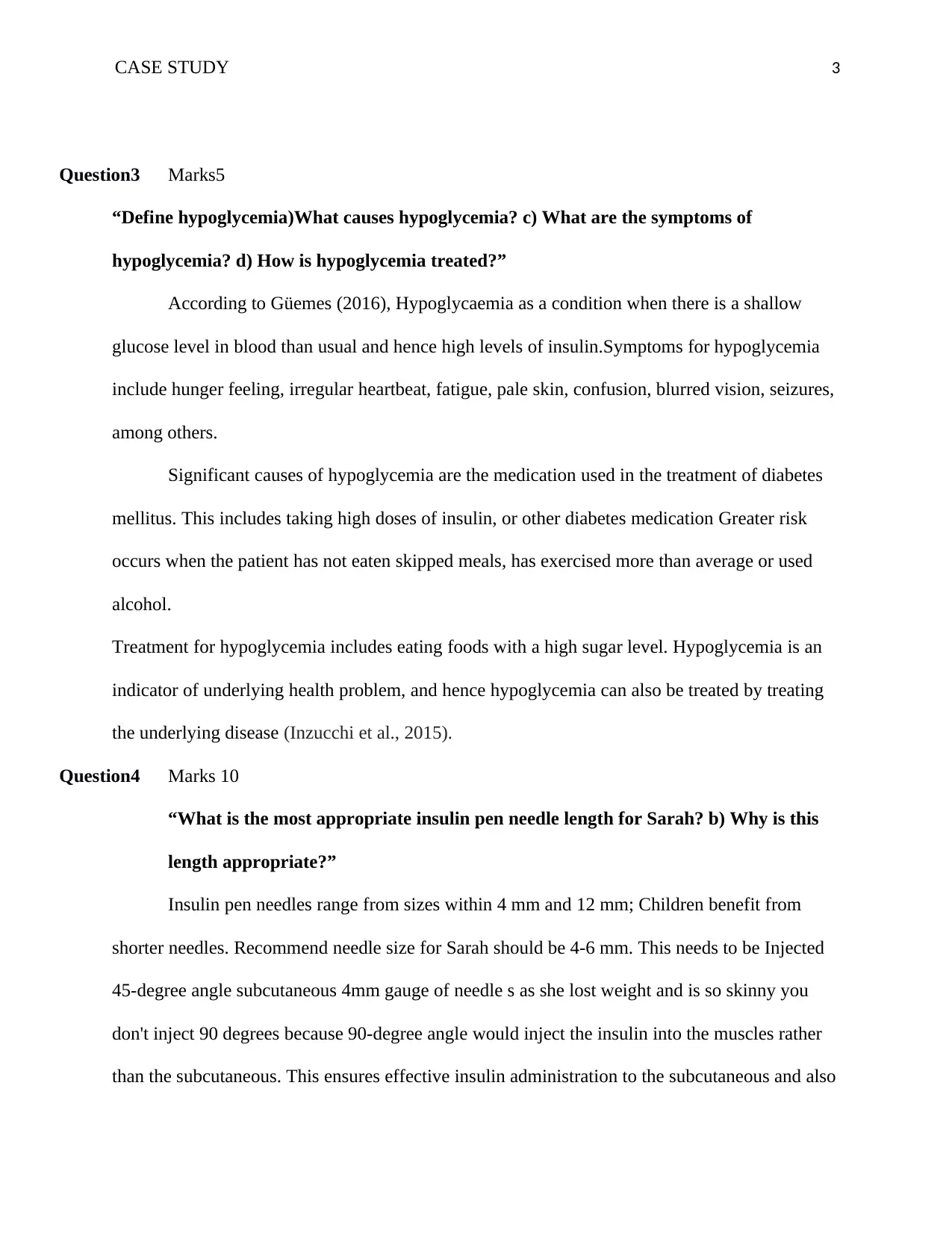
CASE STUDY 3
Question3 Marks5
“Define hypoglycemia)What causes hypoglycemia? c) What are the symptoms of
hypoglycemia? d) How is hypoglycemia treated?”
According to Güemes (2016), Hypoglycaemia as a condition when there is a shallow
glucose level in blood than usual and hence high levels of insulin.Symptoms for hypoglycemia
include hunger feeling, irregular heartbeat, fatigue, pale skin, confusion, blurred vision, seizures,
among others.
Significant causes of hypoglycemia are the medication used in the treatment of diabetes
mellitus. This includes taking high doses of insulin, or other diabetes medication Greater risk
occurs when the patient has not eaten skipped meals, has exercised more than average or used
alcohol.
Treatment for hypoglycemia includes eating foods with a high sugar level. Hypoglycemia is an
indicator of underlying health problem, and hence hypoglycemia can also be treated by treating
the underlying disease (Inzucchi et al., 2015).
Question4 Marks 10
“What is the most appropriate insulin pen needle length for Sarah? b) Why is this
length appropriate?”
Insulin pen needles range from sizes within 4 mm and 12 mm; Children benefit from
shorter needles. Recommend needle size for Sarah should be 4-6 mm. This needs to be Injected
45-degree angle subcutaneous 4mm gauge of needle s as she lost weight and is so skinny you
don't inject 90 degrees because 90-degree angle would inject the insulin into the muscles rather
than the subcutaneous. This ensures effective insulin administration to the subcutaneous and also
Question3 Marks5
“Define hypoglycemia)What causes hypoglycemia? c) What are the symptoms of
hypoglycemia? d) How is hypoglycemia treated?”
According to Güemes (2016), Hypoglycaemia as a condition when there is a shallow
glucose level in blood than usual and hence high levels of insulin.Symptoms for hypoglycemia
include hunger feeling, irregular heartbeat, fatigue, pale skin, confusion, blurred vision, seizures,
among others.
Significant causes of hypoglycemia are the medication used in the treatment of diabetes
mellitus. This includes taking high doses of insulin, or other diabetes medication Greater risk
occurs when the patient has not eaten skipped meals, has exercised more than average or used
alcohol.
Treatment for hypoglycemia includes eating foods with a high sugar level. Hypoglycemia is an
indicator of underlying health problem, and hence hypoglycemia can also be treated by treating
the underlying disease (Inzucchi et al., 2015).
Question4 Marks 10
“What is the most appropriate insulin pen needle length for Sarah? b) Why is this
length appropriate?”
Insulin pen needles range from sizes within 4 mm and 12 mm; Children benefit from
shorter needles. Recommend needle size for Sarah should be 4-6 mm. This needs to be Injected
45-degree angle subcutaneous 4mm gauge of needle s as she lost weight and is so skinny you
don't inject 90 degrees because 90-degree angle would inject the insulin into the muscles rather
than the subcutaneous. This ensures effective insulin administration to the subcutaneous and also
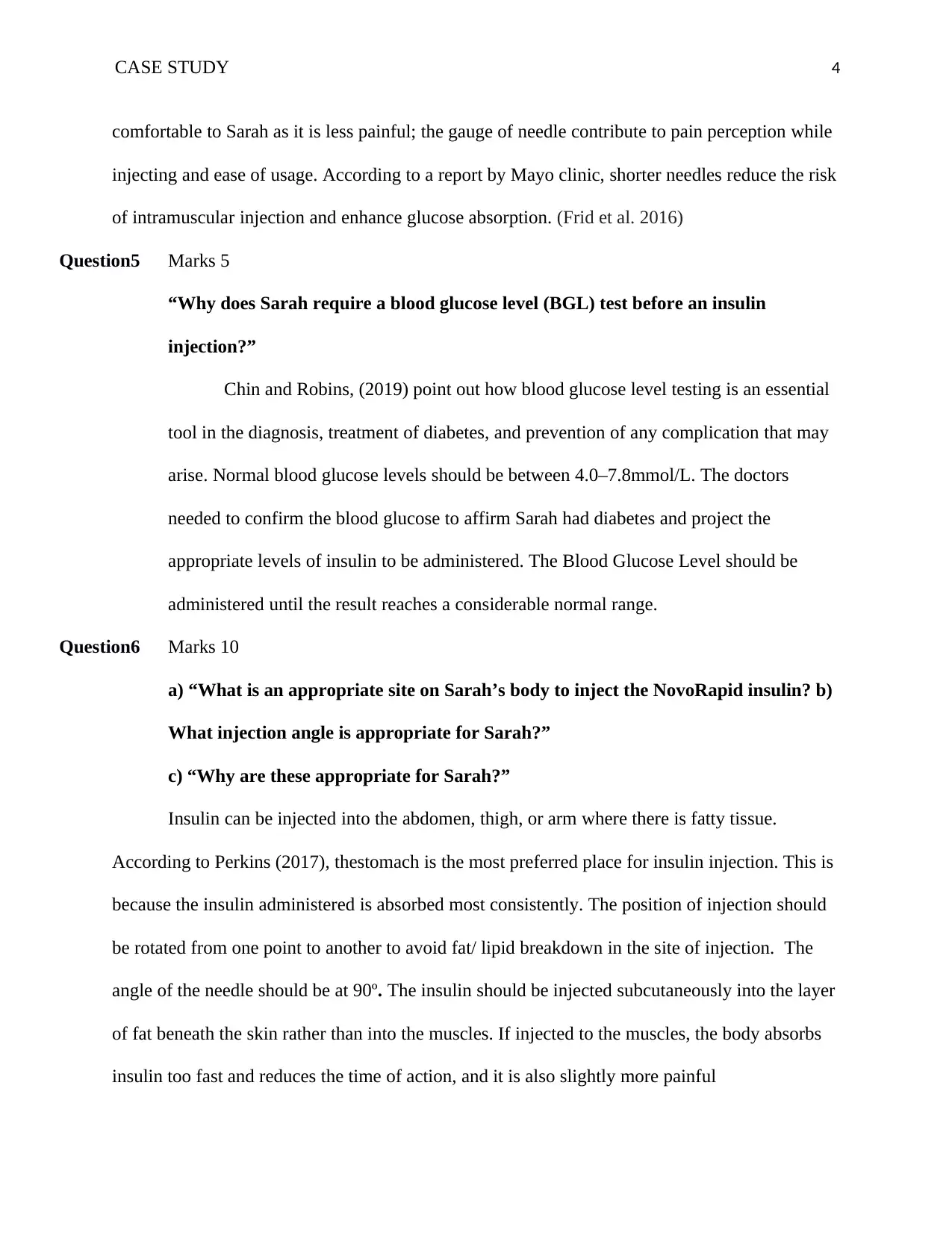
CASE STUDY 4
comfortable to Sarah as it is less painful; the gauge of needle contribute to pain perception while
injecting and ease of usage. According to a report by Mayo clinic, shorter needles reduce the risk
of intramuscular injection and enhance glucose absorption. (Frid et al. 2016)
Question5 Marks 5
“Why does Sarah require a blood glucose level (BGL) test before an insulin
injection?”
Chin and Robins, (2019) point out how blood glucose level testing is an essential
tool in the diagnosis, treatment of diabetes, and prevention of any complication that may
arise. Normal blood glucose levels should be between 4.0–7.8mmol/L. The doctors
needed to confirm the blood glucose to affirm Sarah had diabetes and project the
appropriate levels of insulin to be administered. The Blood Glucose Level should be
administered until the result reaches a considerable normal range.
Question6 Marks 10
a) “What is an appropriate site on Sarah’s body to inject the NovoRapid insulin? b)
What injection angle is appropriate for Sarah?”
c) “Why are these appropriate for Sarah?”
Insulin can be injected into the abdomen, thigh, or arm where there is fatty tissue.
According to Perkins (2017), thestomach is the most preferred place for insulin injection. This is
because the insulin administered is absorbed most consistently. The position of injection should
be rotated from one point to another to avoid fat/ lipid breakdown in the site of injection. The
angle of the needle should be at 90º. The insulin should be injected subcutaneously into the layer
of fat beneath the skin rather than into the muscles. If injected to the muscles, the body absorbs
insulin too fast and reduces the time of action, and it is also slightly more painful
comfortable to Sarah as it is less painful; the gauge of needle contribute to pain perception while
injecting and ease of usage. According to a report by Mayo clinic, shorter needles reduce the risk
of intramuscular injection and enhance glucose absorption. (Frid et al. 2016)
Question5 Marks 5
“Why does Sarah require a blood glucose level (BGL) test before an insulin
injection?”
Chin and Robins, (2019) point out how blood glucose level testing is an essential
tool in the diagnosis, treatment of diabetes, and prevention of any complication that may
arise. Normal blood glucose levels should be between 4.0–7.8mmol/L. The doctors
needed to confirm the blood glucose to affirm Sarah had diabetes and project the
appropriate levels of insulin to be administered. The Blood Glucose Level should be
administered until the result reaches a considerable normal range.
Question6 Marks 10
a) “What is an appropriate site on Sarah’s body to inject the NovoRapid insulin? b)
What injection angle is appropriate for Sarah?”
c) “Why are these appropriate for Sarah?”
Insulin can be injected into the abdomen, thigh, or arm where there is fatty tissue.
According to Perkins (2017), thestomach is the most preferred place for insulin injection. This is
because the insulin administered is absorbed most consistently. The position of injection should
be rotated from one point to another to avoid fat/ lipid breakdown in the site of injection. The
angle of the needle should be at 90º. The insulin should be injected subcutaneously into the layer
of fat beneath the skin rather than into the muscles. If injected to the muscles, the body absorbs
insulin too fast and reduces the time of action, and it is also slightly more painful
Secure Best Marks with AI Grader
Need help grading? Try our AI Grader for instant feedback on your assignments.
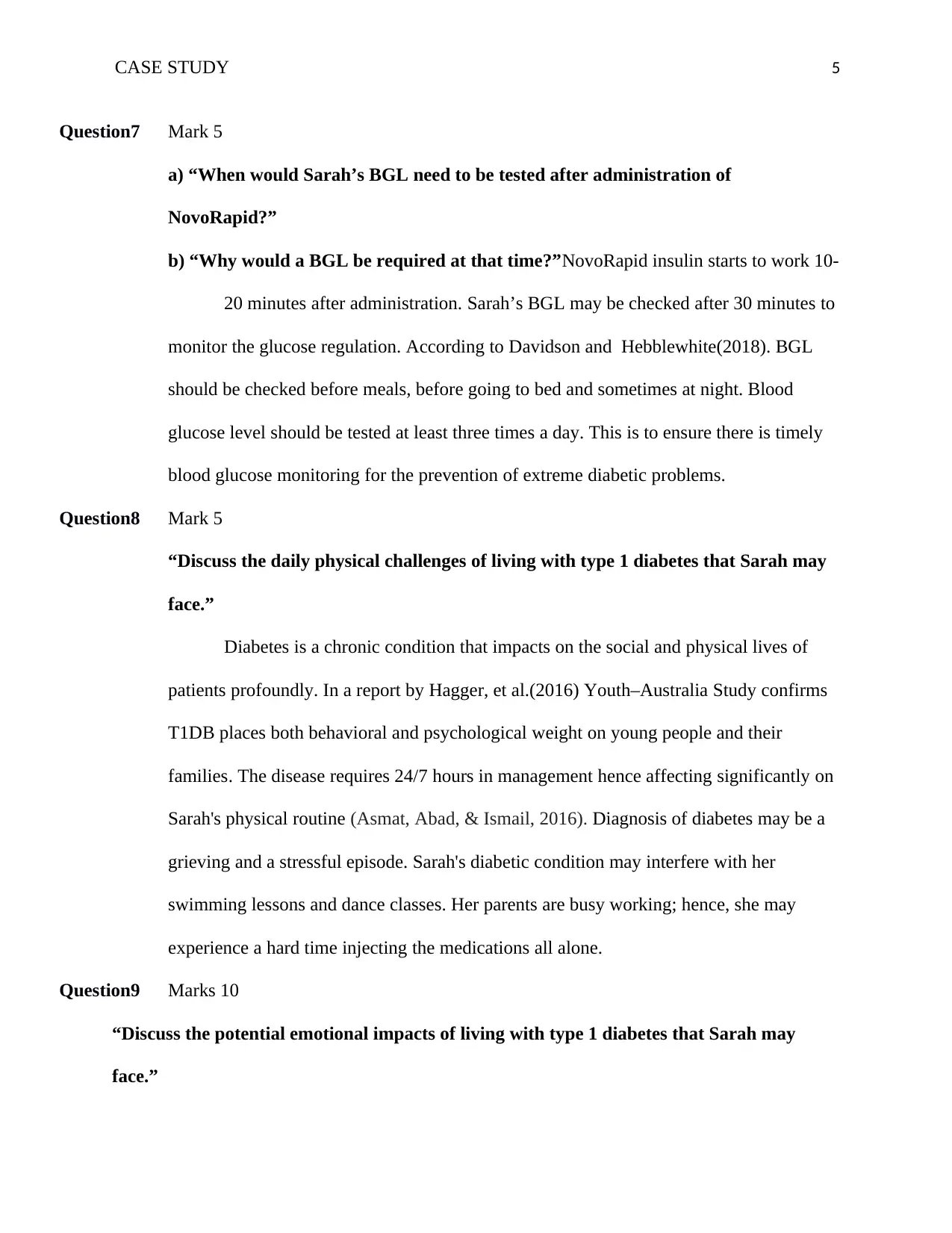
CASE STUDY 5
Question7 Mark 5
a) “When would Sarah’s BGL need to be tested after administration of
NovoRapid?”
b) “Why would a BGL be required at that time?”NovoRapid insulin starts to work 10-
20 minutes after administration. Sarah’s BGL may be checked after 30 minutes to
monitor the glucose regulation. According to Davidson and Hebblewhite(2018). BGL
should be checked before meals, before going to bed and sometimes at night. Blood
glucose level should be tested at least three times a day. This is to ensure there is timely
blood glucose monitoring for the prevention of extreme diabetic problems.
Question8 Mark 5
“Discuss the daily physical challenges of living with type 1 diabetes that Sarah may
face.”
Diabetes is a chronic condition that impacts on the social and physical lives of
patients profoundly. In a report by Hagger, et al.(2016) Youth–Australia Study confirms
T1DB places both behavioral and psychological weight on young people and their
families. The disease requires 24/7 hours in management hence affecting significantly on
Sarah's physical routine (Asmat, Abad, & Ismail, 2016). Diagnosis of diabetes may be a
grieving and a stressful episode. Sarah's diabetic condition may interfere with her
swimming lessons and dance classes. Her parents are busy working; hence, she may
experience a hard time injecting the medications all alone.
Question9 Marks 10
“Discuss the potential emotional impacts of living with type 1 diabetes that Sarah may
face.”
Question7 Mark 5
a) “When would Sarah’s BGL need to be tested after administration of
NovoRapid?”
b) “Why would a BGL be required at that time?”NovoRapid insulin starts to work 10-
20 minutes after administration. Sarah’s BGL may be checked after 30 minutes to
monitor the glucose regulation. According to Davidson and Hebblewhite(2018). BGL
should be checked before meals, before going to bed and sometimes at night. Blood
glucose level should be tested at least three times a day. This is to ensure there is timely
blood glucose monitoring for the prevention of extreme diabetic problems.
Question8 Mark 5
“Discuss the daily physical challenges of living with type 1 diabetes that Sarah may
face.”
Diabetes is a chronic condition that impacts on the social and physical lives of
patients profoundly. In a report by Hagger, et al.(2016) Youth–Australia Study confirms
T1DB places both behavioral and psychological weight on young people and their
families. The disease requires 24/7 hours in management hence affecting significantly on
Sarah's physical routine (Asmat, Abad, & Ismail, 2016). Diagnosis of diabetes may be a
grieving and a stressful episode. Sarah's diabetic condition may interfere with her
swimming lessons and dance classes. Her parents are busy working; hence, she may
experience a hard time injecting the medications all alone.
Question9 Marks 10
“Discuss the potential emotional impacts of living with type 1 diabetes that Sarah may
face.”
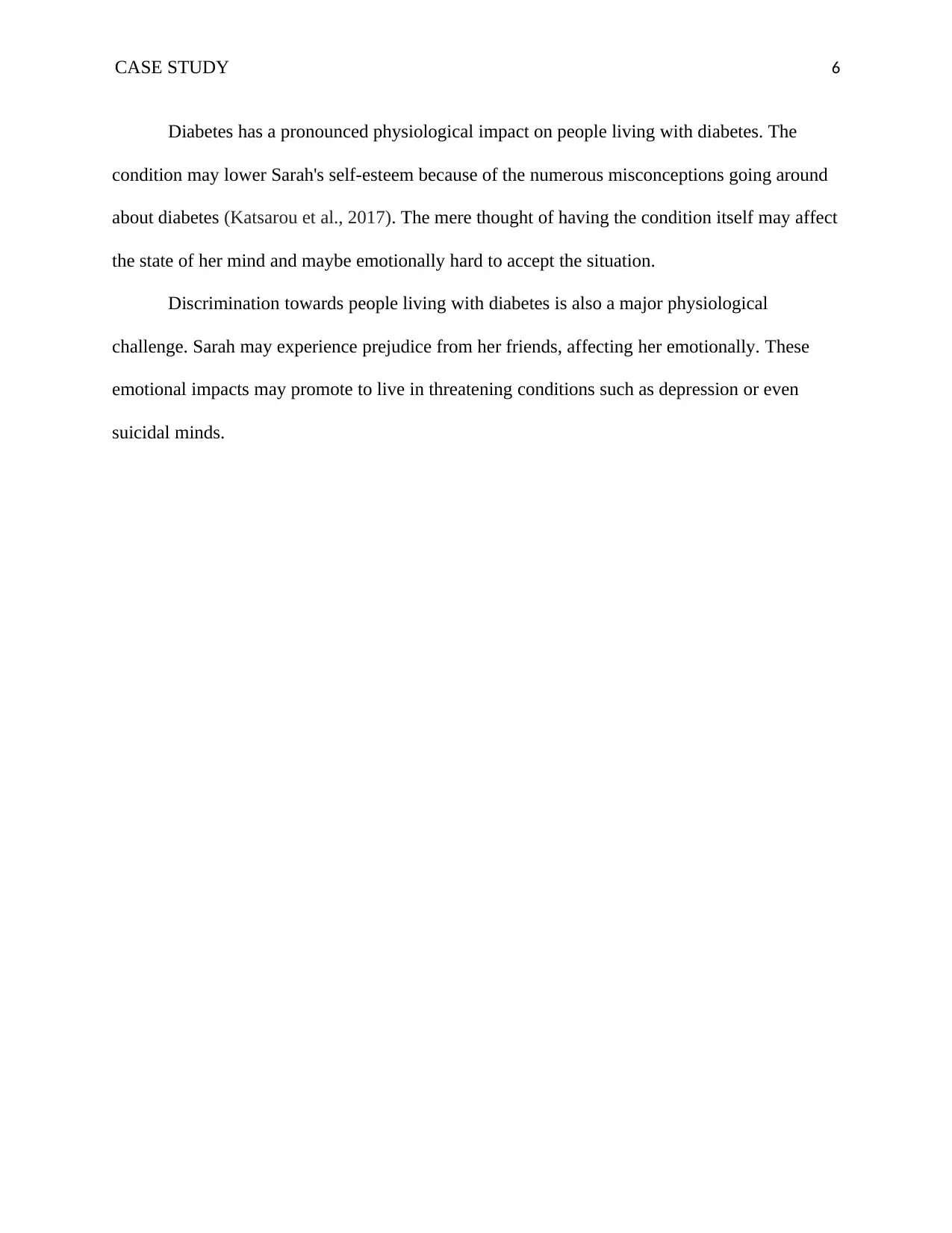
CASE STUDY 6
Diabetes has a pronounced physiological impact on people living with diabetes. The
condition may lower Sarah's self-esteem because of the numerous misconceptions going around
about diabetes (Katsarou et al., 2017). The mere thought of having the condition itself may affect
the state of her mind and maybe emotionally hard to accept the situation.
Discrimination towards people living with diabetes is also a major physiological
challenge. Sarah may experience prejudice from her friends, affecting her emotionally. These
emotional impacts may promote to live in threatening conditions such as depression or even
suicidal minds.
Diabetes has a pronounced physiological impact on people living with diabetes. The
condition may lower Sarah's self-esteem because of the numerous misconceptions going around
about diabetes (Katsarou et al., 2017). The mere thought of having the condition itself may affect
the state of her mind and maybe emotionally hard to accept the situation.
Discrimination towards people living with diabetes is also a major physiological
challenge. Sarah may experience prejudice from her friends, affecting her emotionally. These
emotional impacts may promote to live in threatening conditions such as depression or even
suicidal minds.
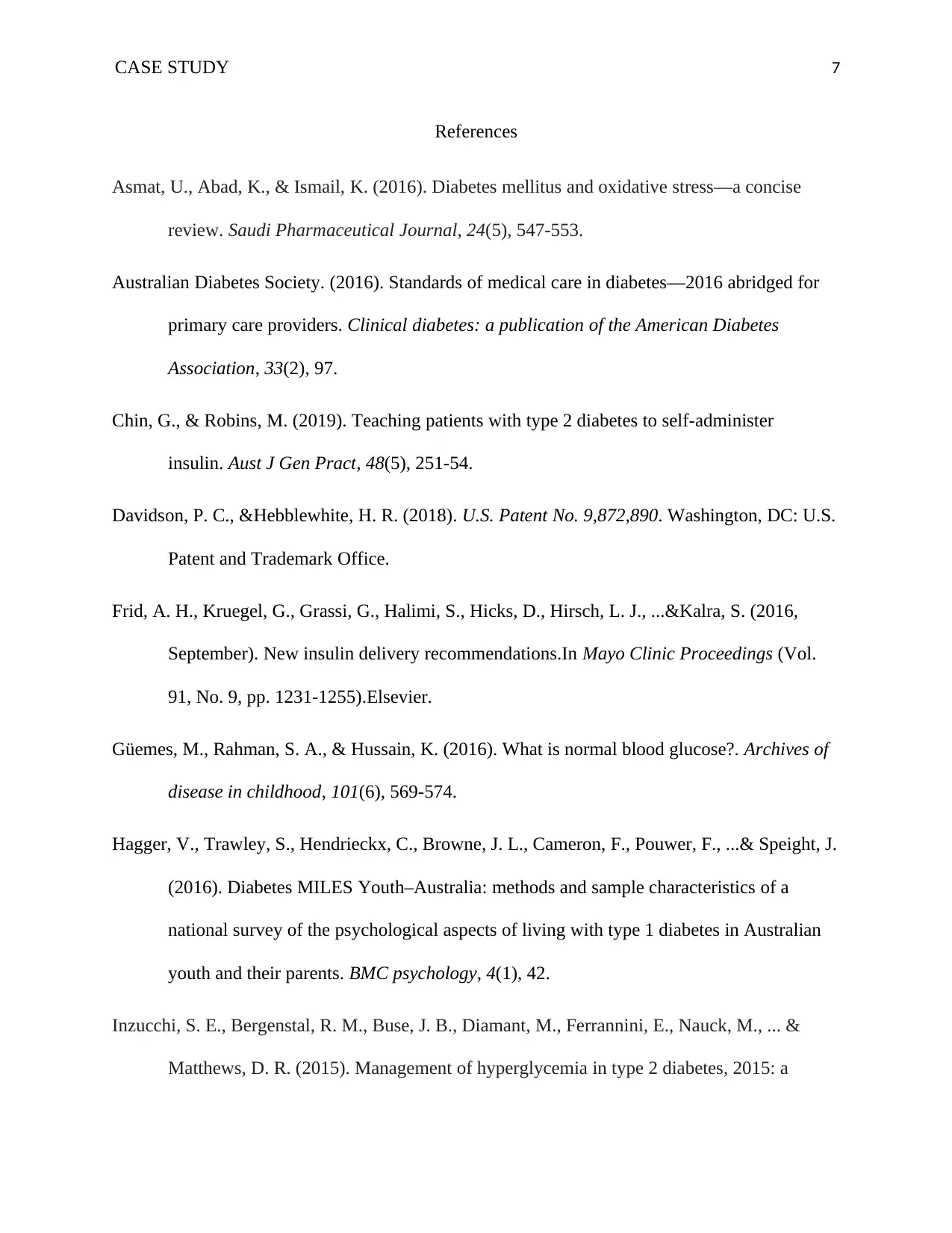
CASE STUDY 7
References
Asmat, U., Abad, K., & Ismail, K. (2016). Diabetes mellitus and oxidative stress—a concise
review. Saudi Pharmaceutical Journal, 24(5), 547-553.
Australian Diabetes Society. (2016). Standards of medical care in diabetes—2016 abridged for
primary care providers. Clinical diabetes: a publication of the American Diabetes
Association, 33(2), 97.
Chin, G., & Robins, M. (2019). Teaching patients with type 2 diabetes to self-administer
insulin. Aust J Gen Pract, 48(5), 251-54.
Davidson, P. C., &Hebblewhite, H. R. (2018). U.S. Patent No. 9,872,890. Washington, DC: U.S.
Patent and Trademark Office.
Frid, A. H., Kruegel, G., Grassi, G., Halimi, S., Hicks, D., Hirsch, L. J., ...&Kalra, S. (2016,
September). New insulin delivery recommendations.In Mayo Clinic Proceedings (Vol.
91, No. 9, pp. 1231-1255).Elsevier.
Güemes, M., Rahman, S. A., & Hussain, K. (2016). What is normal blood glucose?. Archives of
disease in childhood, 101(6), 569-574.
Hagger, V., Trawley, S., Hendrieckx, C., Browne, J. L., Cameron, F., Pouwer, F., ...& Speight, J.
(2016). Diabetes MILES Youth–Australia: methods and sample characteristics of a
national survey of the psychological aspects of living with type 1 diabetes in Australian
youth and their parents. BMC psychology, 4(1), 42.
Inzucchi, S. E., Bergenstal, R. M., Buse, J. B., Diamant, M., Ferrannini, E., Nauck, M., ... &
Matthews, D. R. (2015). Management of hyperglycemia in type 2 diabetes, 2015: a
References
Asmat, U., Abad, K., & Ismail, K. (2016). Diabetes mellitus and oxidative stress—a concise
review. Saudi Pharmaceutical Journal, 24(5), 547-553.
Australian Diabetes Society. (2016). Standards of medical care in diabetes—2016 abridged for
primary care providers. Clinical diabetes: a publication of the American Diabetes
Association, 33(2), 97.
Chin, G., & Robins, M. (2019). Teaching patients with type 2 diabetes to self-administer
insulin. Aust J Gen Pract, 48(5), 251-54.
Davidson, P. C., &Hebblewhite, H. R. (2018). U.S. Patent No. 9,872,890. Washington, DC: U.S.
Patent and Trademark Office.
Frid, A. H., Kruegel, G., Grassi, G., Halimi, S., Hicks, D., Hirsch, L. J., ...&Kalra, S. (2016,
September). New insulin delivery recommendations.In Mayo Clinic Proceedings (Vol.
91, No. 9, pp. 1231-1255).Elsevier.
Güemes, M., Rahman, S. A., & Hussain, K. (2016). What is normal blood glucose?. Archives of
disease in childhood, 101(6), 569-574.
Hagger, V., Trawley, S., Hendrieckx, C., Browne, J. L., Cameron, F., Pouwer, F., ...& Speight, J.
(2016). Diabetes MILES Youth–Australia: methods and sample characteristics of a
national survey of the psychological aspects of living with type 1 diabetes in Australian
youth and their parents. BMC psychology, 4(1), 42.
Inzucchi, S. E., Bergenstal, R. M., Buse, J. B., Diamant, M., Ferrannini, E., Nauck, M., ... &
Matthews, D. R. (2015). Management of hyperglycemia in type 2 diabetes, 2015: a
Paraphrase This Document
Need a fresh take? Get an instant paraphrase of this document with our AI Paraphraser
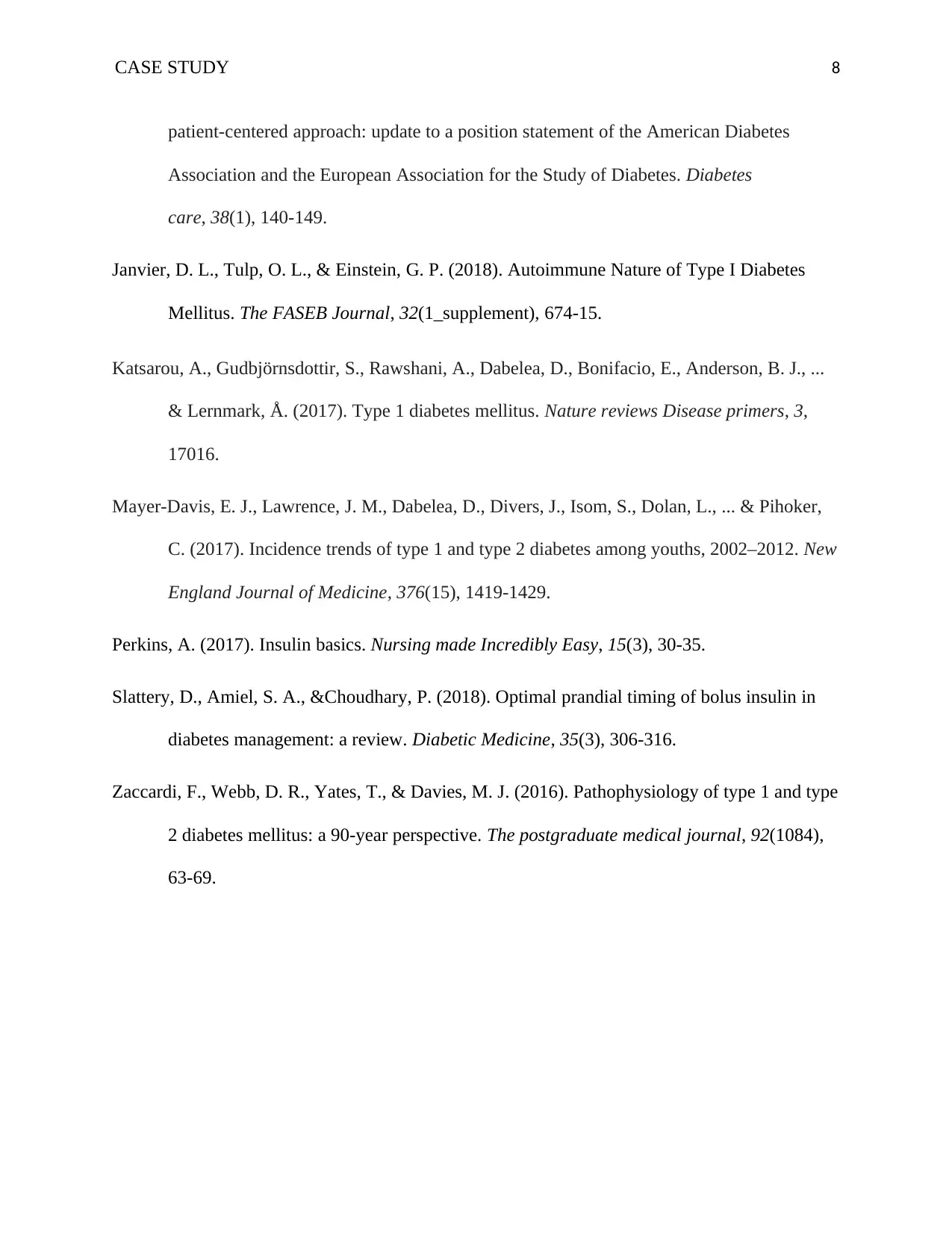
CASE STUDY 8
patient-centered approach: update to a position statement of the American Diabetes
Association and the European Association for the Study of Diabetes. Diabetes
care, 38(1), 140-149.
Janvier, D. L., Tulp, O. L., & Einstein, G. P. (2018). Autoimmune Nature of Type I Diabetes
Mellitus. The FASEB Journal, 32(1_supplement), 674-15.
Katsarou, A., Gudbjörnsdottir, S., Rawshani, A., Dabelea, D., Bonifacio, E., Anderson, B. J., ...
& Lernmark, Å. (2017). Type 1 diabetes mellitus. Nature reviews Disease primers, 3,
17016.
Mayer-Davis, E. J., Lawrence, J. M., Dabelea, D., Divers, J., Isom, S., Dolan, L., ... & Pihoker,
C. (2017). Incidence trends of type 1 and type 2 diabetes among youths, 2002–2012. New
England Journal of Medicine, 376(15), 1419-1429.
Perkins, A. (2017). Insulin basics. Nursing made Incredibly Easy, 15(3), 30-35.
Slattery, D., Amiel, S. A., &Choudhary, P. (2018). Optimal prandial timing of bolus insulin in
diabetes management: a review. Diabetic Medicine, 35(3), 306-316.
Zaccardi, F., Webb, D. R., Yates, T., & Davies, M. J. (2016). Pathophysiology of type 1 and type
2 diabetes mellitus: a 90-year perspective. The postgraduate medical journal, 92(1084),
63-69.
patient-centered approach: update to a position statement of the American Diabetes
Association and the European Association for the Study of Diabetes. Diabetes
care, 38(1), 140-149.
Janvier, D. L., Tulp, O. L., & Einstein, G. P. (2018). Autoimmune Nature of Type I Diabetes
Mellitus. The FASEB Journal, 32(1_supplement), 674-15.
Katsarou, A., Gudbjörnsdottir, S., Rawshani, A., Dabelea, D., Bonifacio, E., Anderson, B. J., ...
& Lernmark, Å. (2017). Type 1 diabetes mellitus. Nature reviews Disease primers, 3,
17016.
Mayer-Davis, E. J., Lawrence, J. M., Dabelea, D., Divers, J., Isom, S., Dolan, L., ... & Pihoker,
C. (2017). Incidence trends of type 1 and type 2 diabetes among youths, 2002–2012. New
England Journal of Medicine, 376(15), 1419-1429.
Perkins, A. (2017). Insulin basics. Nursing made Incredibly Easy, 15(3), 30-35.
Slattery, D., Amiel, S. A., &Choudhary, P. (2018). Optimal prandial timing of bolus insulin in
diabetes management: a review. Diabetic Medicine, 35(3), 306-316.
Zaccardi, F., Webb, D. R., Yates, T., & Davies, M. J. (2016). Pathophysiology of type 1 and type
2 diabetes mellitus: a 90-year perspective. The postgraduate medical journal, 92(1084),
63-69.
1 out of 8
Related Documents
Your All-in-One AI-Powered Toolkit for Academic Success.
+13062052269
info@desklib.com
Available 24*7 on WhatsApp / Email
![[object Object]](/_next/static/media/star-bottom.7253800d.svg)
Unlock your academic potential
© 2024 | Zucol Services PVT LTD | All rights reserved.





